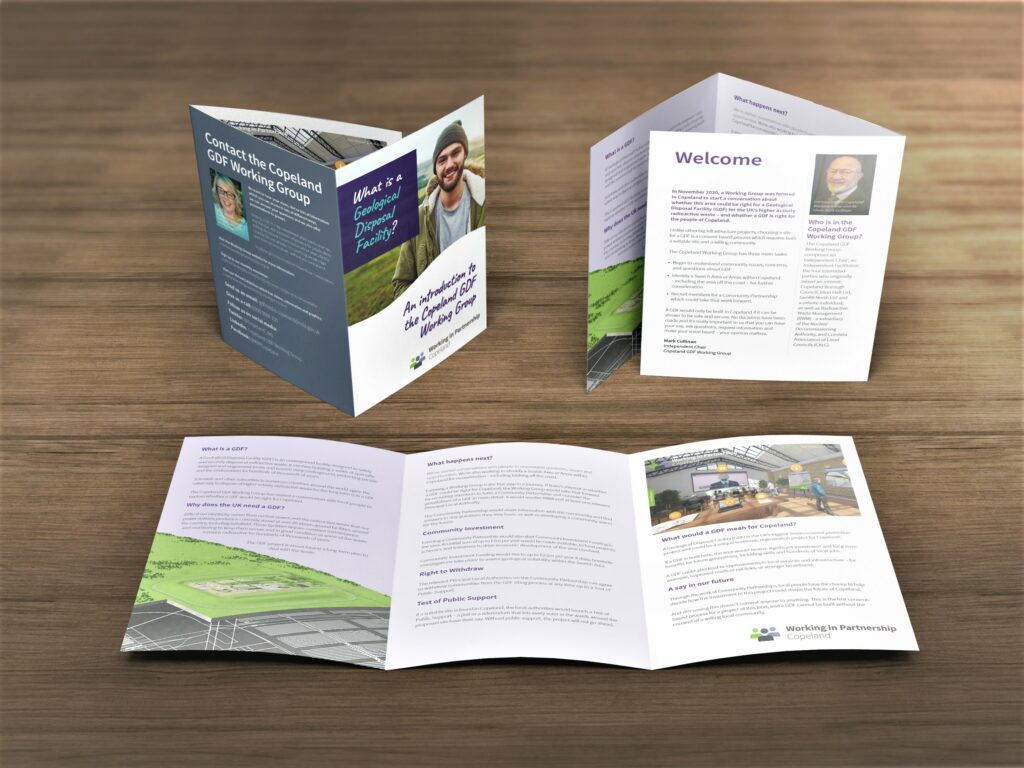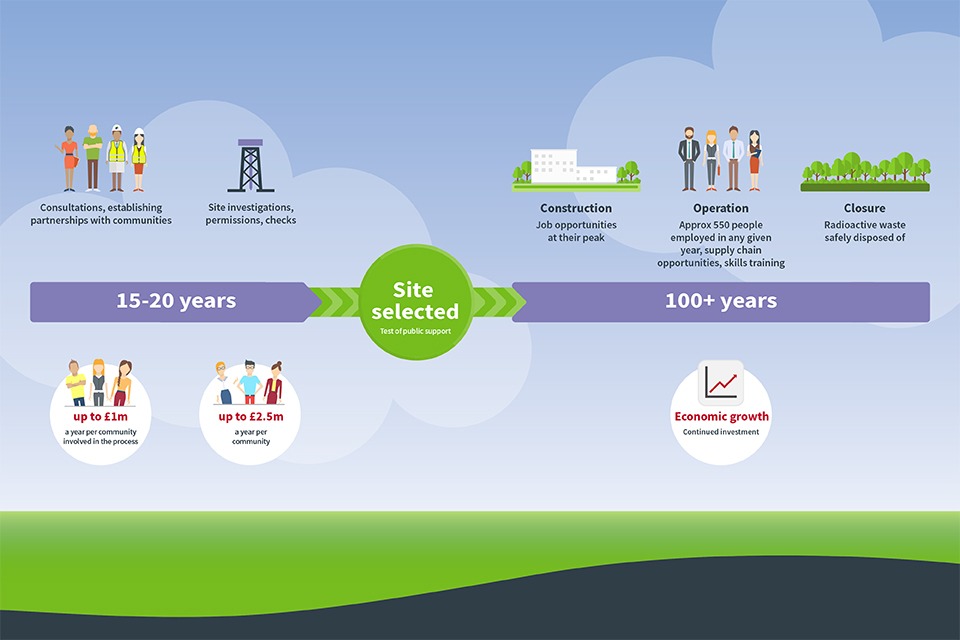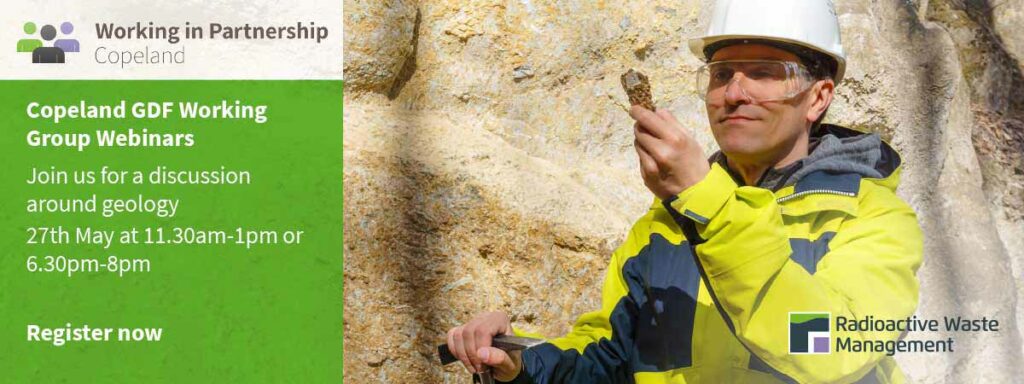
Copeland GDF Working Group Newsletter
Welcome to the May edition of the Copeland GDF Working Group newsletter.
In this month’s publication you will see our plans for further community engagement – including online webinars and a face to face exhibition roadshow. We also have details of what the community benefits of a Geological Disposal Facility could be and a blog from Copeland Mayor, Mike Starkie.
The Working Group is planning a three-week public exhibition out and about around Copeland if Covid restrictions continue to ease. We’re hoping to visit eight locations from July 1-24 providing information, allowing people to ask questions, having face to face discussions and meeting Working Group members.
If you want to know more about geological disposal for higher activity radioactive waste, how a suitable site for a GDF is identified, what it could mean for Copeland, how a community partnership is formed and what it will do – as well as subjects including geology, safety and the environment – please put the dates in your diary and look out for more details soon. We look forward to the opportunity of having a conversation with you.
There’ll be geologists, scientists and engineers from Radioactive Waste Management (RWM) visiting to answer your questions, plus some digital and interactive activities. So do look out for our advertising and publicity materials which will provide you with all the information you need to sign up to attend.
We’ll be inviting people to register for their preferred location beforehand, to help us manage each venue’s Covid capacities, or you can telephone to let us know you’d like to come and we’ll register your intention to visit. If you want to turn up on the day, you’ll be able to go in when there’s a safe space available, however there may be a wait if the venue is fully booked at that time.
Before then, we have some more online events – this time on the subject of geology. This will cover many different aspects around the topic and there will be an opportunity to ask your questions and have them answered by RWM and other independent guest speakers.
We’re having breakout discussions as part of the webinars to allow us to explore topics in smaller groups. The events will be held on Thursday, May 27 – read on in the newsletter for further details and times.
We’ve just passed the six-month mark of the day the Copeland GDF Working Group launched in November. It has three main tasks – begin local conversations and start to understand community issues, concerns and questions about GDF; identify a search area or areas within Copeland for further consideration and recruit initial members for a Community Partnership which could take that work forward.
Our work includes starting those very important conversations with people, local groups and organisations as well as asking for views. We’ve been providing information, questions and answers, offering online discussions and meetings, while encouraging people to get in touch. Our work on search areas is also progressing.
The website has lots of information from what and who the Working Group is, to what GDF is, latest news and ways to get involved: https://midcopeland.workinginpartnership.org.uk/
You can also visit our Virtual Exhibition – an interactive digital experience to find out more information about geological disposal and what it could mean for Copeland: https://midcopeland.workinginpartnership.org.uk/get-involved/
As always, the Working Group welcomes any requests for information or talks, views can be shared and questions can be asked by contacting us via email: gdfinfo-copeland@nda.gov.uk telephone 0300 369 0000 or writing to: Copeland GDF Working Group, GDF Enquiries, PO Box 734, Swansea SA1 9RP.

Mark Cullinan
Independent Chair
Copeland GDF Working Group
Would you like a leaflet?
The Copeland GDF Working Group has produced an information leaflet about the group and GDF which is available for anyone who would like a copy. Please get in touch if this is something which would be useful to you, or several copies can be sent if you are part of a group or organisation. Drop us a line via email: gdfinfo-copeland@nda.gov.uk telephone 0300 369 0000 or write to: Copeland GDF Working Group, GDF Enquiries, PO Box 734, Swansea SA1 9RP.

What are the community benefits of a GDF?
This month we consider the community benefits of a Geological Disposal Facility (GDF). This could include millions of pounds of community investment funding which is triggered once a Community Partnership is formed, as well as significant additional investment, economic and employment opportunities for a community which eventually hosts a GDF.
The process of finding a suitable site for a GDF, somewhere in England and Wales, could take up to 15 years. Although that may seem a long way off, the multi-billion investment of a GDF would be transformational for an area.

Early benefits of forming a Community Partnership
As part of its role to start a conversation around GDF locally and identify a Search Area(s) – the Copeland GDF Working Group will begin to identify local people who may be interested in joining a Community Partnership – a group which will go on to consider possibilities in more detail. This partnership would also involve Radioactive Waste Management (RWM) and at least one relevant Principal Local Authority – such as district or county councils.
It’s at this point of forming a Community Partnership that community investment funding of up to £1 million a year will be available. This figure rises to up to £2.5 million a year once deep borehole investigations start, part of the process to understand the geology.
The funding would be available to applicants in the form of grants for each community that forms a Community Partnership. In allocating resources, the Community Partnership will listen to local views and priorities, for example, supporting sports, economic development, tourism and community wellbeing.
Community investment funding will be available for as long as the Community Partnership is part of the process.
 Mike Brophy, Radioactive Waste Management’s Head of Social Impact, said: “The commitment to this early funding arose from reviewing previous GDF discussions which ended in 2013. Throughout the process, people understood that the GDF would have brought massive benefits – but when the process ended, none of those benefits could be realised. Now, communities can use the investment funding before any commitment to a GDF, benefiting from engaging in the process whatever the outcome.
Mike Brophy, Radioactive Waste Management’s Head of Social Impact, said: “The commitment to this early funding arose from reviewing previous GDF discussions which ended in 2013. Throughout the process, people understood that the GDF would have brought massive benefits – but when the process ended, none of those benefits could be realised. Now, communities can use the investment funding before any commitment to a GDF, benefiting from engaging in the process whatever the outcome.
“This time, communities will be at the heart of the siting process for a GDF and a facility will only be built where there’s both a suitable site and a willing community.”
The role of the Community Partnership includes developing a vision for the future about how a GDF could benefit a community over the long term and what significant improvements people would like to see in their area.
Communities have an ongoing right of withdrawal from discussions and the local population must give consent to host a facility, through a test of public support, before a planning application for a facility can be made. Only following a positive test of public support and after the relevant permissions from the independent regulators have been obtained, could construction start.
Significant future investment and job creation
Once a site has been eventually chosen for a GDF, investment in local infrastructure such as road, rail, power and broadband networks would be needed to enable its construction and operation.
Significant additional investment will also become available to that host community. This will replace the Community Investment Funding and recognise the long-term commitment from the community. This significant investment could include improved local education and skills capacity, improved transport infrastructure or recreational facilities, developing community facilities and business opportunities.
This major infrastructure project would also bring hundreds of well-paid jobs every year for over a century in construction, engineering, safety and project management (with opportunity for the jobs and skills to be undertaken and developed by people in the community) plus further opportunities for the local supply chain.
Successful operation of a GDF could also require a number of facilities such as training and visitor centres, plus Research and Development, bringing additional employment.
Mike added: “RWM is committed to making the most of every opportunity to have a positive local impact, and we have started already by employing staff and contracting with suppliers from the area. Many infrastructure projects create jobs, many of them highly skilled. What makes a GDF different, is that while the initial GDF construction phase will stretch over around 10 years and require a workforce of up to 2,000 during the peak period – the total construction and operation will take well over 100 years, employing local people and supporting local businesses.
“Construction activities will continue throughout its operational lifetime as the network of tunnels and vaults are extended stage by stage. A GDF will be receiving waste for more than a century.
“Some jobs will require external specialists, but many skills will be available locally, along with suppliers. We plan to recruit as many local people and businesses as possible, as well as invest in training to build sufficient expertise for the operational years ahead. When we understand more about a potential location, we’ll be able to develop a clearer picture.”
For a summary of community benefits, see this video: https://youtu.be/6irCmnoiIck
Geology focus for Copeland GDF Working Group webinars

Geology will be the focus for the next online events from the Copeland GDF Working Group.
After listening to local feedback – geology is a subject which people have questions around in relation to what a Geological Disposal Facility (GDF) for higher activity radioactive waste could mean for Copeland.
These latest online events will be held on Thursday, May 27, 11.30am-1pm or 6.30pm-8pm. Please register by going to: https://copelandGDF.rwmevents.co.uk
The webinars will involve discussion groups, opportunity for questions and will include members of the Working Group, Radioactive Waste Management (RWM), regulators the Environment Agency and Office for Nuclear Regulation (ONR) and independent geologists from the British Geological Survey (BGS).
Working Group Chair Mark Cullinan said: “Geology is a topic which often comes up locally and therefore we wanted it to be a focus for these events to allow people to hear from experts and to ask their own questions.
“We plan to break out into smaller groups to allow more in-depth discussion to take place during the 90-minute sessions. Do register to learn more, ask your questions and give your views.”
The webinar will examine different aspects of the geology in Copeland including from a historical perspective; the suitability of the geology found in Copeland for a Geological Disposal Facility (GDF) and also the safety of a future GDF.
The Working Group is available to speak to groups, help to answer questions and provide information. Please get in touch by email: gdfinfo-copeland@nda.gov.uk or telephone 0300 369 0000. For further information, see the website: www.midcopeland.workinginpartnership.org.uk where you can also sign up for a monthly newsletter and please also visit the virtual exhibition: www.midcopeland.workinginpartnership.org.uk/get-involved/
Copeland Mayor Mike Starkie shares his views around geological disposal
 “I’d like to thank the GDF Working Group for inviting me to share my views on this vitally important process currently taking place in Copeland.
“I’d like to thank the GDF Working Group for inviting me to share my views on this vitally important process currently taking place in Copeland.
“The work that is under way to assess whether there is a willing host community and suitable place in our locality to accommodate a Geological Disposal Facility is of significant national importance and, quite rightly, is attracting substantial interest and opinion. But what is not up for debate is that the Copeland borough has a significant role to play in this process, regardless of the final location of a GDF in England or Wales.
“As the host borough of the Sellafield site, Copeland is home to the vast majority of the inventory identified for disposal in a GDF. Once a GDF becomes available – wherever it is – activity at Sellafield will change as the site becomes the front-end of GDF operations, thereby having major implications for our local area.
It is our obligation to our people, communities and environment to engage in the process and, on this basis and after a process of strategic analysis, Copeland Council reached the decision last year to join the Copeland GDF Working Group as an Interested Party.
“We have been pleased to engage in the ‘working with communities’ process, led by Radioactive Waste Management (RWM), that has taken place thus far, and I’d like to publicly recognise the hard work being carried out by Chair Mark Cullinan and his Working Group colleagues, including Copeland Council’s Deputy Mayor David Moore and our council officers. However, it is important to note that our involvement does not imply that a GDF will be built in Copeland.
The role of the Working Group is to identify a search area to be explored in more detail in terms of suitability, and to start to understand the views of the local community. This is absolutely key, and I am encouraging all Copeland residents to get involved in the process now by engaging with the Working Group via the various channels available.
“At the potential next stage of forming a Community Partnership, this stakeholder engagement will intensify and it is vital that the voice of the community is represented in decisions about if – and how – a GDF fits into the vision for Copeland’s future, and stakeholders from the wider community would have the opportunity to get involved as members of the partnership.
This process is to find BOTH a suitable site and a willing host community, and no decisions about whether or not to host a GDF will be taken without a future test of public support. But now is the time to get involved, to help shape the process from this initial stage until it reaches its conclusion; whatever that conclusion may be.”
Meet the Team – Karen Agnew
 Karen is the Copeland GDF Working Group’s Secretariat, her role involves supporting the Independent Chair and wider administrative tasks. Originally from Ayrshire in Scotland and now living in Cumbria after a 25-year journey across the UK, Karen spent over 10 years working as a Serviced Office Manager.
Karen is the Copeland GDF Working Group’s Secretariat, her role involves supporting the Independent Chair and wider administrative tasks. Originally from Ayrshire in Scotland and now living in Cumbria after a 25-year journey across the UK, Karen spent over 10 years working as a Serviced Office Manager.
Karen then joined Price Waterhouse Cooper as Office Manager and was promoted into the role of Secretarial Manager North East, before taking a career break in 2017.
“I felt I was ready for a new challenge and a career opportunity which I’m delighted to have found here with Copeland Working Group and Radioactive Waste Management as part of the GDF programme,” said Karen.
Open to question
Is there a connection between any potential for a GDF in Cumbria and plans for a deep coal mine in Whitehaven?
There are absolutely no plans to consider existing or future coal mines for the geological disposal of radioactive waste, because they are simply not suitable.
Radioactive Waste Management (RWM) is responsible for developing a deep GDF in the UK, where higher-activity radioactive waste will be disposed of, based on consent from a willing community together with a suitable site.
A GDF will be a purpose-built, highly engineered facility designed specifically for radioactive waste. RWM will assess the suitability of any potential GDF location in a comprehensive evaluation process. The design and safety features must meet the stringent requirements of independent UK nuclear and environmental regulators. A coal mine would not meet these requirements.
At what depths will a GDF be built?
A GDF will be constructed between 200 and around 1,000 metres deep underground. At this depth the waste will be protected from human intervention and from natural events and processes such earthquakes, tsunamis and long-term environmental change such as future ice ages or sea level changes.
How long will a GDF last?
The multiple barriers of a GDF will keep radiation away from the surface until the level of radioactivity decreases so that it no longer represents a hazard. This timescale is of the order of hundreds of thousands of years.
What is a community partnership?
Should there be continued interest in whether a GDF could be hosted in the Copeland area, a Community Partnership would be the larger, enduring group of people that would take over from the Working Group and consider the possibilities of local GDF siting in more detail, including further public engagement and creating a “Community Vision” for the long-term well-being of the community.
It will include community members and organisations, seeking to be reflective of the local community. It will provide a vehicle for sharing information and for finding answers to the questions about geological disposal, the siting process and how the community could benefit.
Formation of a Community Partnership would require the participation of Radioactive Waste Management (RWM) and at least one relevant Principal Local Authority (district/county councils) for the area being considered. The Relevant Principal Local Authorities on the Community Partnership can agree to withdraw communities from the GDF siting process at any time.
The formation of a Community Partnership would signify the start of Community Investment Funding in the area. An initial sum of up to £1m per year would be made available, which could be used to fund projects, schemes and initiatives to drive the economic development of the area, improve the local environment, or the community’s wellbeing. This would rise to £2.5m per year if deep borehole investigations take place to assess geological suitability within the Search Area.
